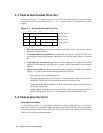
Introduction 1–1
Chapter 1
Introduction
Alpha is a 64-bit load/store RISC architecture that is designed with particular emphasis on the
three elements that most affect performance: clock speed, multiple instruction issue, and multi-
ple processors.
The Alpha architects examined and analyzed current and theoretical RISC architecture design
elements and developed high-performance alternatives for the Alpha architecture. The archi-
tects adopted only those design elements that appeared valuable for a projected 25-year design
horizon. Thus, Alpha becomes the first 21st century computer architecture.
The Alpha architecture is designed to avoid bias toward any particular operating system or pro-
gramming language. Alpha supports the OpenVMS Alpha, DIGITAL UNIX, and Windows NT
Alpha operating systems and supports simple software migration for applications that run on
those operating systems.
This manual describes in detail how Alpha is designed to be the leadership 64-bit architecture
of the computer industry.
1.1 The Alpha Approach to RISC Architecture
Alpha Is a True 64-Bit Architecture
Alpha was designed as a 64-bit architecture. All registers are 64 bits in length and all opera-
tions are performed between 64-bit registers. It is not a 32-bit architecture that was later
expanded to 64 bits.
Alpha Is Designed for Very High-Speed Implementations
The instructions are very simple. All instructions are 32 bits in length. Memory operations are
either loads or stores. All data manipulation is done between registers.
The Alpha architecture facilitates pipelining multiple instances of the same operations because
there are no special registers and no condition codes.
The instructions interact with each other only by one instruction writing a register or memory
and another instruction reading from the same place. That makes it particularly easy to build
implementations that issue multiple instructions every CPU cycle.


















